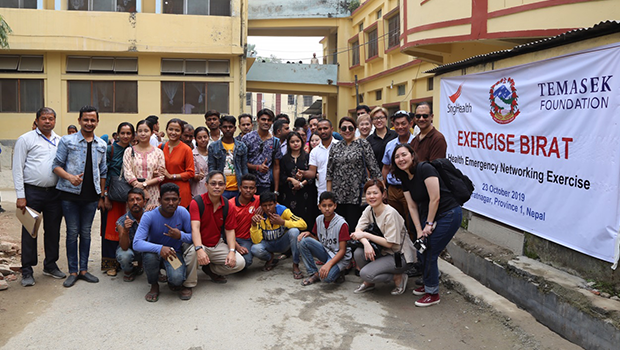
Healthcare teams from SingHealth and Koshi Zonal Hospital with participants of the air crash disaster simulation exercise
A three-year project led by Professor Venkataraman Anantharaman, Senior Consultant, Department of Emergency Medicine, Singapore General Hospital (SGH), in Biratnagar, Nepal came to a close with an air crash disaster simulation exercise in October. Over 80 government officials as well as medical professionals in Nepal participated in the exercise.
Prof V. Anantharaman said, “The 3-year programme with Temasek Foundation came to a successful close with the disaster simulation exercise in Nepal which focused on testing the disaster response systems and coordination between the various government agencies involved in disaster management, including the National Health Emergency Operations Centre (Health EOC), Provincial Health EOCs, as well as the hospitals and their cluster command centres.”

‘Casualties’ are triaged at the First Aid Post and sent to appropriate hospitals via ambulances
Importance of emergency preparedness programme in Nepal
Nepal’s geographical location makes it prone to both natural and man-made disasters such as earthquakes, floods and aviation accidents. In March 2018, one of the worst aviation disasters hit the country in years. The US-Bangla Airlines Flight 211 crash took 51 lives out of the 71 people onboard. To mitigate the effects and recover quickly from such disasters, it is critical that the government agencies and healthcare workers are equipped with a high level of disaster preparedness.

Project lead Prof Anantha (foreground, in white shirt) speaking with Health Ministry officials and hospital leaders from Biratnagar about the exercise
How has Singapore Helped?
Funded by Temasek Foundation and jointly developed by the Government of Nepal and SingHealth, the programme has equipped over 700 Nepalese healthcare leaders, doctors, nurses and allied health professionals with the necessary expertise to manage post disaster emergencies till date. This includes ensuring timely response and recovery, as well as developing disaster response systems and protocols to ensure strong governance and preparedness.

Healthcare teams at the Provincial Health Emergency Operations Centre coordinating the health service response to the air crash
The programme curriculum focuses on key areas such as community first responder training, on-site management of disasters and emergency ambulance system training. Nurses and allied health professionals were trained in trauma management encompassing critical care, orthopaedic, chest and limb physiotherapy, trauma nursing, and post-traumatic stress counselling. Doctors, nurses and allied health professionals from Singapore conducted clinical training in Nepal through three annual trips.

A First Aid Post was set up at the ‘disaster site’ to triage ‘casualties’

SingHealth and Temasek Foundation teams with Prime Minister of Nepal, Khadga Prasad Sharma Oli
Apart from training in Nepal, 20 select participants were brought to Singapore to be trained as master trainers in May 2019. During their week-long visit, they learnt about Singapore’s healthcare system and policies as well as SingHealth’s governance, organisational structures and workflows in disaster management. They also witnessed a simulated demonstration of how a chemical disaster is managed medically at the Singapore General Hospital.
These master trainers went on to train many other healthcare practitioners back in Nepal, and together with the various training programmes over the past three years, amplified efforts to equip more Nepalese healthcare professionals with the tools to deal with post disaster recovery.













 Get it on Google Play
Get it on Google Play